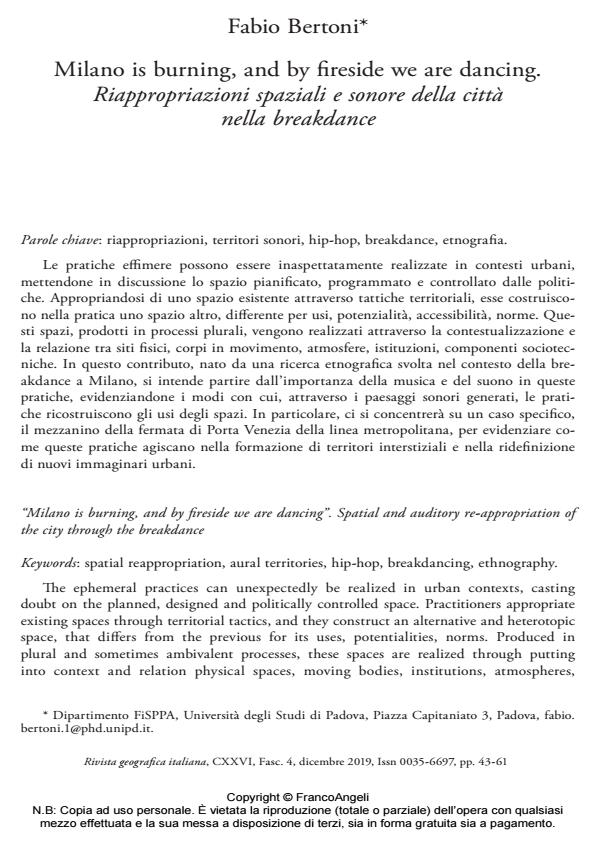Milano is burning, and by fireside we are dancing. Riappropriazioni spaziali e sonore della città nella breakdance
Titolo Rivista RIVISTA GEOGRAFICA ITALIANA
Autori/Curatori Fabio Bertoni
Anno di pubblicazione 2019 Fascicolo 2019/4
Lingua Italiano Numero pagine 19 P. 43-61 Dimensione file 143 KB
DOI 10.3280/RGI2019-004003
Il DOI è il codice a barre della proprietà intellettuale: per saperne di più
clicca qui
Qui sotto puoi vedere in anteprima la prima pagina di questo articolo.
Se questo articolo ti interessa, lo puoi acquistare (e scaricare in formato pdf) seguendo le facili indicazioni per acquistare il download credit. Acquista Download Credits per scaricare questo Articolo in formato PDF

FrancoAngeli è membro della Publishers International Linking Association, Inc (PILA)associazione indipendente e non profit per facilitare (attraverso i servizi tecnologici implementati da CrossRef.org) l’accesso degli studiosi ai contenuti digitali nelle pubblicazioni professionali e scientifiche
Le pratiche effimere possono essere inaspettatamente realizzate in contesti urbani, mettendone in discussione lo spazio pianificato, programmato e controllato dalle politiche. Appropriandosi di uno spazio esistente attraverso tattiche territoriali, esse costruiscono nella pratica uno spazio altro, differente per usi, potenzialita, accessibilita, norme. Questi spazi, prodotti in processi plurali, vengono realizzati attraverso la contestualizzazione e la relazione tra siti fisici, corpi in movimento, atmosfere, istituzioni, componenti sociotecniche. In questo contributo, nato da una ricerca etnografica svolta nel contesto della breakdance a Milano, si intende partire dall’importanza della musica e del suono in queste pratiche, evidenziandone i modi con cui, attraverso i paesaggi sonori generati, le pratiche ricostruiscono gli usi degli spazi. In particolare, ci si concentrera su un caso specifico, il mezzanino della fermata di Porta Venezia della linea metropolitana, per evidenziare come queste pratiche agiscano nella formazione di territori interstiziali e nella ridefinizione di nuovi immaginari urbani.
Parole chiave:Riappropriazioni, territori sonori, hip-hop, breakdance, etnografia
Fabio Bertoni, Milano is burning, and by fireside we are dancing. Riappropriazioni spaziali e sonore della città nella breakdance in "RIVISTA GEOGRAFICA ITALIANA" 4/2019, pp 43-61, DOI: 10.3280/RGI2019-004003